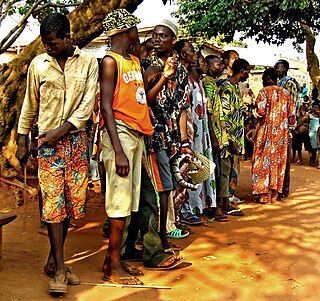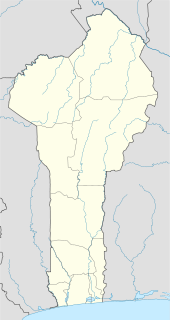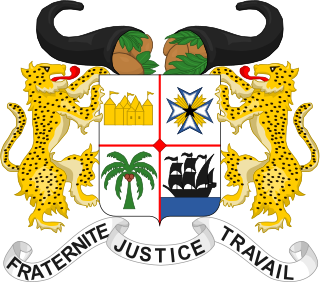
Abomey is the capital of the Zou Department of Benin. The commune of Abomey covers an area of 142 square kilometres and, as of 2012, had a population of 90,195 people.
The Aja are an ethnic group native to south-western Benin and south-eastern Togo. According to oral tradition, the Aja migrated to southern Benin in the 12th or 13th centuries from Tado on the Mono River, and c. 1600, three brothers, Kokpon, Do-Aklin, and Te-Agdanlin, split the ruling of the region then occupied by the Aja amongst themselves: Kokpon took the capital city of Great Ardra, reigning over the Allada kingdom; Do-Aklin founded Abomey, which would become capital of the Kingdom of Dahomey; and Te-Agdanlin founded Little Ardra, also known as Ajatche, later called Porto Novo by Portuguese traders and the current capital city of Benin.

Bohicon is a city in Benin, and a conurbation of Abomey lying 9 kilometres east of the city on the railway line from Cotonou to Parakou and on Benin's main highway RNIE 2 which joins the RNIE 4. The commune covers an area of 139 square kilometres and as of 2002 had a population of 113,091 people.

Trafficking of children is a form of human trafficking and is defined by the United Nations as the "recruitment, transportation, transfer, harboring, and/or receipt" kidnapping of a child for the purpose of slavery, forced labor and exploitation. This definition is substantially wider than the same document's definition of "trafficking in persons". Children may also be trafficked for the purpose of adoption.

Zou is one of the twelve departments of Benin, named for the Zou River which travels through the department before emptying into the Atlantic in the south of the country. The department of Zou was split in two in 1999, with the northern territory transferred to the newly created Collines Department. The capital of Zou is Abomey. Zou is subdivided into nine communes, each centred at one of the principal towns: Abomey, Agbangnizoun, Bohicon, Cové, Djidja, Ouinhi, Za-Kpota, Zangnanado and Zogbodomey.

Cové is a city in the Zou Department of Benin. The commune covers an area of 525 square kilometres and as of 2012 had a population of 43,554 people.

The following outline is provided as an overview of and topical guide to Benin:
Togo is a source, transit and, to a lesser extent, a destination country for women and children trafficked for the purposes of forced labor and commercial sexual exploitation. Trafficking within Togo is more prevalent than transnational trafficking and the majority of victims are children. Togolese girls are trafficked primarily within the country for domestic servitude, as market vendors, produce porters, and for commercial sexual exploitation. To a lesser extent, girls are also trafficked to other African countries, primarily Benin, Nigeria, Ghana, and Niger for the same purposes listed above. Togolese boys are most commonly trafficked transnationally to work in agricultural labor in other African countries, primarily Nigeria, Ivory Coast, Gabon, and Benin, though some boys are also trafficked within the country for market labor. Beninese and Ghanaian children have also been trafficked to Togo. There have been reports of Togolese women and girls trafficked to Lebanon and Saudi Arabia, likely for domestic servitude and sexual exploitation. Togolese women may be trafficked to Europe, primarily to France and Germany, for domestic servitude and sexual exploitation. In the last year, 19 Togolese girls and young women were trafficked to the United States for forced labor in a hair salon. The Government of Togo does not fully comply with the minimum standards for the elimination of trafficking; however, it is making significant efforts to do so, despite limited resources. Togo demonstrated solid law enforcement efforts by increasing the number of traffickers convicted. However, sentences imposed on convicted traffickers were inadequate and protection efforts were diminished over last year.

Agbangnizoun is a town, arrondissement, and commune in the Zou Department of south-western Benin. The town lies 20 kilometres south-east of Abomey. The commune covers an area of 244 square kilometres and as of 2002 had a population of 55,001 people.

Djidja is a town, arrondissement, and commune in the Zou Department of south-western Benin. The commune covers an area of 2184 square kilometres and as of 2013 had a population of 123,542 people.

Ouinhi is a town, arrondissement, and commune in the Zou Department of south-western Benin. The commune covers an area of 483 square kilometres and as of 2013 had a population of 59,381 people. It is bounded on the north-west by the commune of Zagnanado, south-west by the commune of Zogbodomey, south by the commune of Bonou and east by the commune of Adja-Ouèrè. The commune is divided into arrondisements which include Dasso, Ouinhi, and Tohu, comprising 28 villages.

Zagnanado or Zangnanado is a town, arrondissement, and commune in the Zou Department of southern-central Benin. It is located 47 kilometres from Abomey and 165 kilometres north of Cotonou. The commune covers an area of 750 square kilometres and as of 2013 had a population of 132,401 people.

The 2008 Benin floods struck the nation of Benin between July and October 2008, and affected the other West African nations of Burkina Faso, Mali, Mauritania, Niger and Togo. According to the Red Cross of Benin, the flooding in Benin initially affected almost 7,000 people, including the displacement of 1,560 children. and by August 19, 2008, the World Health Organization (WHO) estimated that the flooding had displaced at least 150,000 people. Some 500,000 people in total were at risk of additional flooding.
Benin, officially the Republic of Benin, is a country in Western Africa. It borders Togo to the west, Nigeria to the east and Burkina Faso and Niger to the north; its short coastline to the south leads to the Bight of Benin. Its size is just over 110000 km2 with a population of almost 8500000. Its capital is the Yoruba founded city of Porto Novo, but the seat of government is the Fon city of Cotonou. About half the population live below the international poverty line of US$1.25 per day.

Arrondissements are administrative units of Benin, after departments and communes. In turn they contain villages and may often have several quartiers or city districts/urban neighborhoods. There are currently 545 arrondissements.
Benin is a country of origin and transit for children subjected to trafficking in persons, specifically conditions of forced labor and forced prostitution. Until recently, analysts also considered Benin a destination country for foreign children brought to the country and subjected to forced labor, but new information from government and non-government sources indicates the total number of such children is not significant. The majority of victims are girls trafficked into domestic servitude or the commercial sex trade in Cotonou, the administrative capital. Some boys are forced to labor on farms, work in construction, produce handicrafts, or hawk items on the street. Many traffickers are relatives or acquaintances of their victims, exploiting the traditional system of vidomegon, in which parents allow their children to live with and work for richer relatives, usually in urban areas. There are reports that some tourists visiting Pendjari National Park in northern Benin exploit underage girls in prostitution, some of whom may be trafficking victims. Beninese children recruited for forced labor exploitation abroad are destined largely for Nigeria and Gabon, with some also going to Ivory Coast and other African countries, where they may be forced to work in mines, quarries, or the cocoa sector.
Gabon is primarily a transit country for children from Benin, Nigeria, Togo, Mali, Guinea, and other West African countries who are subjected to human trafficking, specifically forced labor and forced prostitution. Some victims transit through Gabon en route to exploitation in Equatorial Guinea. According to UNICEF, the majority of victims are boys who are forced to work as street hawkers or mechanics. Girls generally are subjected to conditions of involuntary domestic servitude, or forced labor in markets or roadside restaurants. Stepped-up coastal surveillance over the past year – especially following the October 2009 arrival in Gabonese waters of a sea vessel that was carrying 34 child trafficking victims, some of whom were destined for Equatorial Guinea – caused traffickers to change their routes, which included utilizing estuaries and rivers to transport children. The majority of victims were young girls, a departure from previous patterns of trafficking in the region. Trafficking offenders appear to operate in loose ethnic-based crime networks. Most child traffickers are women, who serve as intermediaries in their countries of origin. In some cases, child victims report that their parents had turned them over to intermediaries promising employment opportunities in Gabon. The government has no reports of international organized crime syndicates, employment agencies, marriage brokers, or travel services facilitating trafficking in Gabon. In 2009, the government began tracking a new trend of young adults between ages 18 and 25 being forced into domestic servitude or prostitution in Gabon.
Chad is a source and destination country for children subjected to trafficking in persons, specifically conditions of forced labor and forced prostitution. The country's trafficking problem is primarily internal and frequently involves parents entrusting children to relatives or intermediaries in return for promises of education, apprenticeship, goods, or money; selling or bartering children into involuntary domestic servitude or herding is used as a means of survival by families seeking to reduce the number of mouths to feed. Child trafficking victims are primarily subjected to forced labor as herders, domestic servants, agricultural laborers, or beggars. Child cattle herders follow traditional routes for grazing cattle and at times cross ill-defined international borders into Cameroon, the Central African Republic (CAR), and Nigeria. Underage Chadian girls travel to larger towns in search of work, where some are subsequently subjected to prostitution. Some girls are compelled to marry against their will, only to be forced by their husbands into involuntary domestic servitude or agricultural labor. In past reporting periods, traffickers transported children from Cameroon and the CAR to Chad's oil producing regions for commercial sexual exploitation; it is unknown whether this practice persisted in 2009.
Human trafficking in the Ivory Coast refers to the practice of forced labour and commercial sexual exploitation which uses Côte d'Ivoire a source, transit, and destination country for women and children who are trafficked for these purposes. Trafficking within the country's borders is more prevalent, with victims primarily trafficked from the north of the country to the more economically prosperous south. Boys from Ghana, Mali, and Burkina Faso are subjected to forced labour in the agricultural sector, including on cocoa, coffee, pineapple, and rubber plantations; boys from Ghana are forced to labour in the mining sector; boys from Togo are forced to work in construction; and boys from Benin are forced to work in carpentry and construction. Girls recruited from Ghana, Togo, and Benin to work as domestic servants and street vendors often are subjected to conditions of forced labour. Women and girls are also recruited from Ghana and Nigeria to work as waitresses in restaurants and bars and are subsequently subjected to forced prostitution. Trafficked children often face harsh treatment and extreme working conditions.
Prostitution in the Gambia is widespread but illegal. Most of the estimated 3,100 prostitutes in the Gambia are from Sierra Leone, Liberia, and Guinea. Prostitution takes place on the beach, in bars and hotels on the coast. Away from the coast, prostitution mainly takes place in bars. The bars are frequently raided and the foreign prostitutes deported. They often return within a few days.











